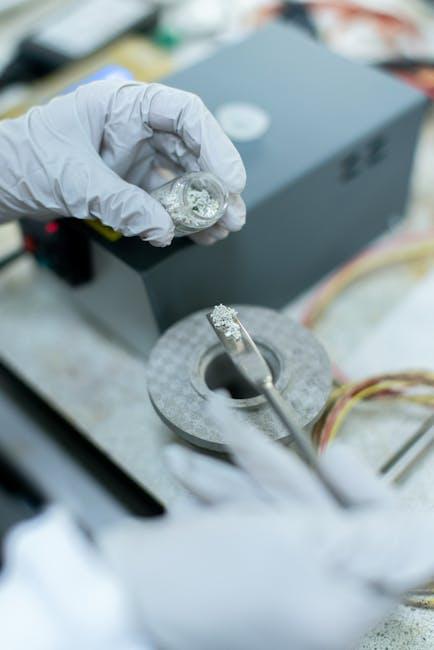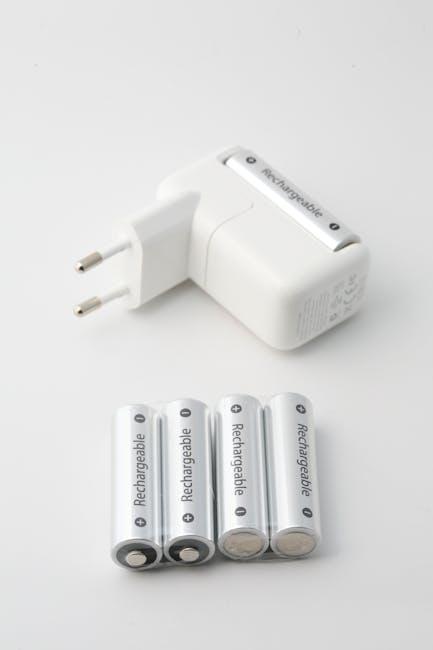In the vast world of energy storage, batteries serve as the silent powerhouses behind everything from our cars to renewable energy systems. Among the many types available, AGM (Absorbent Glass Mat) and traditional lead-acid batteries often take center stage, each boasting unique designs and characteristics that cater to different needs. Yet, despite their shared chemistry, these two battery types diverge in construction, performance, and application, making the choice between them more than just a simple decision. This article explores the subtle—and sometimes striking—differences between AGM and lead-acid batteries, illuminating how each one powers our everyday lives in its own distinctive way.
Table of Contents
- Understanding the Core Chemistry and Design of AGM and Lead-Acid Batteries
- Performance Comparison in Various Applications and Environments
- Maintenance Requirements and Longevity Expectations Explained
- Safety Considerations and Handling Precautions for Each Battery Type
- Cost Analysis and Value Over the Battery Lifecycle
- Choosing the Right Battery Based on Usage Needs and Environmental Impact
- Q&A
- In Conclusion

Understanding the Core Chemistry and Design of AGM and Lead-Acid Batteries
The heart of both AGM (Absorbent Glass Mat) and traditional lead-acid batteries lies in their fundamental chemistry, which uses lead dioxide (PbO2) as the positive plate, sponge lead (Pb) as the negative plate, and sulfuric acid (H2SO4) as the electrolyte. However, what sets AGM batteries apart is the way the electrolyte is immobilized within fiberglass mats, soaking it up like a sponge. This design not only prevents the acid from freely flowing within the battery but also enhances charge efficiency and reduces water loss during operation. By contrast, traditional flooded lead-acid batteries contain liquid electrolyte that freely covers the plates, necessitating careful maintenance and ventilation to manage gas emissions during charge cycles.
In terms of design, AGM batteries offer several distinct advantages due to their sealed, maintenance-free construction:
- Vibration resistance: The tightly packed mat minimizes plate movement, making them ideal for environments with heavy vibrations.
- Reduced gassing: The sealed design captures gases and recombines them internally, allowing for a spill-proof experience.
- Faster charging: AGM’s low internal resistance supports quicker charge acceptance.
Meanwhile, traditional flooded batteries remain popular for their lower upfront cost and simplicity in manufacturing, though their open design demands regular electrolyte checks and watering. The table below highlights a quick comparison:
| Feature | AGM Battery | Flooded Lead-Acid Battery |
|---|---|---|
| Electrolyte | Absorbed in glass mats (immobilized) | Free liquid electrolyte |
| Maintenance | Maintenance-free | Requires regular electrolyte level checks |
| Gas Emission | Minimal, recombined internally | Vented, requires ventilation |
| Durability | High resistance to vibration | Moderate, less resistant to shock |

Performance Comparison in Various Applications and Environments
AGM batteries excel in high-performance scenarios due to their low internal resistance, allowing for rapid discharge and recharge cycles. This makes them a prime choice for applications demanding consistent power bursts, such as in electric vehicles, solar energy storage, and uninterruptible power supplies (UPS). Additionally, AGM batteries perform reliably across a broad temperature range, maintaining capacity in colder environments where traditional lead-acid variants may falter. Their sealed construction also prevents acid spills, making them ideal for mobile or rugged environments including marine and off-road use.
Conversely, conventional lead-acid batteries show their strengths in static applications where weight and size are less critical factors. Their robust design and simpler manufacturing process make them cost-effective for stationary power backup systems and traditional automotive use. However, they tend to require regular maintenance, such as water refilling, and degrade faster under deep discharge conditions. Below is a concise comparison showcasing their relative performance in different settings:
| Application | AGM Battery | Lead-Acid Battery |
|---|---|---|
| Electric Vehicles | High cycling ability, lightweight | Lower cycle life, heavier |
| Solar Storage | Efficient deep cycling, maintenance-free | Requires maintenance, shorter lifespan |
| Marine Use | Spill-proof, vibration resistant | Prone to leaks, less durable |
| Stationary Backup | Compact, costlier | Bulkier, low upfront cost |
- Charge efficiency: AGM outperforms with faster recharge rates.
- Temperature tolerance: AGM maintains better capacity in cold climates.
- Maintenance: Lead-acid requires more upkeep.
- Cost effectiveness: Lead-acid batteries often come with a lower price tag initially.

Maintenance Requirements and Longevity Expectations Explained
When considering the upkeep of AGM versus traditional Lead-Acid batteries, it’s clear that AGM models require significantly less hands-on attention. These batteries are designed to be maintenance-free, sealed units that eliminate the need for water refilling or electrolyte level checks. Their durable construction minimizes corrosion risks and reduces the chance of acid spillage, making them an excellent choice for users who want a hassle-free experience. On the other hand, Lead-Acid batteries often demand regular monitoring and maintenance rituals such as topping up distilled water and cleaning terminals to prevent performance degradation.
Longevity expectations also vary noticeably depending on the battery type and usage conditions. AGM batteries generally boast a longer lifespan, thanks to their robust internal structure and resistance to vibration and temperature extremes. They typically stretch out 3 to 5 years under optimal circumstances. Lead-Acid batteries, while initially less costly, tend to have a shorter operational life, usually ranging from 2 to 4 years, especially if maintenance is neglected. The following table summarizes these key differences:
| Feature | AGM Battery | Lead-Acid Battery |
|---|---|---|
| Maintenance | None required | Regular water topping and terminal cleaning |
| Typical Lifespan | 3 – 5 years | 2 – 4 years |
| Resistance | Vibration and temperature resistant | More susceptible to damage |

Safety Considerations and Handling Precautions for Each Battery Type
AGM batteries demand careful attention to avoid deep discharges and overcharging, as these can drastically shorten their lifespan. Due to their sealed design, they emit minimal gases but still require charging in well-ventilated areas to prevent pressure build-up. Protective gloves and goggles are recommended when handling to guard against any acid leaks, especially after a physical impact. Always use chargers specifically designed for AGM technology to maintain battery efficiency and safety.
Traditional lead-acid batteries, being vented and maintenance-intensive, present distinct handling challenges. These batteries release hydrogen gas during charging, which is highly flammable, so ensuring proper ventilation in storage and charging environments is critical. Regular inspection for acid spills and top-ups with distilled water safeguard performance and reduce corrosion risks. Due caution should be exercised to avoid short circuits, and appropriate personal protective equipment (PPE) like acid-resistant clothing and eye protection is essential.
| Battery Type | Common Safety Risks | Precautions |
|---|---|---|
| AGM | Overcharging, sealed pressure build-up | Use proper charger, ventilated space, PPE |
| Lead-Acid | Hydrogen gas, acid spills, corrosion | Ventilation, inspect acid levels, acid-resistant PPE |

Cost Analysis and Value Over the Battery Lifecycle
When evaluating the financial commitment of AGM versus traditional lead-acid batteries, it’s essential to consider not just the upfront cost but the entire lifecycle value. AGM batteries typically demand a higher initial investment due to their advanced design and superior materials, yet they often span a longer service life with minimal maintenance. This means less frequent replacements and reduced downtime, which can translate to overall savings despite the initial price difference. In contrast, lead-acid batteries possess a lower purchase price but may require more regular upkeep and earlier replacement, subtly increasing their long-term expenses.
To illustrate, here’s a concise comparison of key cost factors over the lifecycle:
| Cost Factor | AGM Battery | Lead-Acid Battery |
|---|---|---|
| Initial Purchase Price | Higher | Lower |
| Maintenance Needs | Minimal (sealed design) | Regular (water refills, cleaning) |
| Replacement Frequency | Lower (long lifespan) | Higher (shorter lifespan) |
| Total Ownership Cost | Competitive (due to longevity) | Can be higher |
- AGM batteries excel in scenarios demanding reliability and low maintenance, thereby compensating for their initial cost over time.
- Lead-acid batteries may be suitable for tight budgets initially but often incur hidden expenses with frequent upkeep and replacements.

Choosing the Right Battery Based on Usage Needs and Environmental Impact
Selecting the ideal battery starts with understanding your unique power demands and the environment in which the battery will operate. AGM batteries excel in scenarios requiring deep cycling and vibration resistance, making them perfect for off-grid solar setups, marine applications, and recreational vehicles. On the other hand, traditional lead-acid batteries often suit less frequent use or backup power systems where cost-effectiveness is paramount. Consider whether you need frequent recharge cycles, maintenance-free performance, or enhanced safety; these criteria will guide your choice substantially.
From an environmental perspective, both batteries carry pros and cons. AGM batteries generally have lower acid spillage risks and a longer service life, reducing waste frequency. Meanwhile, lead-acid batteries, while bulkier and requiring more upkeep, can often be recycled more easily due to their simpler construction. Below is a quick comparison to help clarify these points in context:
| Factor | AGM Battery | Lead-Acid Battery |
|---|---|---|
| Maintenance | Maintenance-free | Requires periodic checks |
| Life Span | Longer cycle life | Shorter cycle life |
| Environmental Risk | Lower acid spillage risk | Higher spillage risk |
| Recyclability | Recyclable but complex | Highly recyclable |
Q&A
Q&A: Understanding the Difference Between AGM and Lead-Acid Batteries
Q1: What does AGM stand for, and how is it related to lead-acid batteries?
A1: AGM stands for Absorbent Glass Mat. It is a type of lead-acid battery where the electrolyte is absorbed in a fiberglass mat, distinguishing it from traditional flooded lead-acid batteries that contain liquid acid freely. Essentially, AGM is a specialized form within the lead-acid battery family.
Q2: How do AGM batteries differ from conventional flooded lead-acid batteries in construction?
A2: AGM batteries use a tightly packed glass mat separator soaked with electrolyte, which immobilizes the acid and prevents leakage. Flooded lead-acid batteries, on the other hand, have liquid acid freely sitting at the bottom, requiring careful handling to avoid spills and evaporation.
Q3: Are there performance differences between AGM and flooded lead-acid batteries?
A3: Yes. AGM batteries typically offer better performance by providing higher power output, faster recharge times, and improved cycling capabilities. Because the electrolyte is immobilized, AGM batteries also resist vibration and shock better, making them ideal for demanding applications.
Q4: What about maintenance—how do AGM and flooded lead-acid batteries compare?
A4: AGM batteries are often called maintenance-free because they’re sealed and don’t require regular topping off of electrolyte. Flooded lead-acid batteries require periodic checks and refilling with distilled water to maintain optimal performance and lifespan.
Q5: Which battery type is safer to use?
A5: AGM batteries tend to be safer due to their sealed design, reduced risk of acid spills, and negligible off-gassing under normal conditions. Flooded lead-acid batteries, because of their liquid acid, pose a higher risk if damaged or improperly handled.
Q6: How does cost factor into the choice between AGM and lead-acid batteries?
A6: Flooded lead-acid batteries generally have a lower upfront cost, making them attractive for budget-sensitive applications. In contrast, AGM batteries are more expensive initially but may offer better value over time due to longer life and less maintenance.
Q7: Which applications are best suited for AGM batteries?
A7: AGM batteries are ideal for modern vehicles, motorcycles, marine applications, uninterruptible power supplies (UPS), and any use where durability, maintenance-free operation, and vibration resistance are critical.
Q8: Can you recycle AGM and lead-acid batteries?
A8: Yes! Both AGM and flooded lead-acid batteries are highly recyclable. Recycling helps recover valuable materials and prevents environmental contamination, so proper disposal through recycling programs is encouraged.
Q9: Should I switch to AGM if I’m currently using flooded lead-acid batteries?
A9: It depends on your needs. If you require a maintenance-free battery with better performance and durability, AGM is a great upgrade. However, if cost is the main concern and you can handle regular maintenance, traditional flooded lead-acid batteries remain a viable choice.
Q10: In summary, what’s the main takeaway about AGM vs. lead-acid batteries?
A10: AGM batteries offer a modern twist on the classic lead-acid design, providing enhanced performance, safety, and convenience in a sealed, leak-proof package. Flooded lead-acid batteries, while older and simpler, still serve well in many cost-sensitive, less demanding roles. Choosing between them depends on the balance of cost, maintenance, and performance needs.
In Conclusion
In the ever-evolving landscape of energy storage, understanding the subtle yet significant differences between AGM and lead-acid batteries empowers you to make informed choices tailored to your needs. Whether it’s the sealed, maintenance-free design of AGM or the tried-and-true reliability of traditional lead-acid variants, each offers unique advantages that shine in different applications. By grasping their distinctive characteristics, you can navigate the world of batteries with confidence, ensuring your power solutions are both efficient and enduring. After all, in the quest for energy, knowing your battery is half the charge.


2 Comments
fv1i1e
fv1i1e